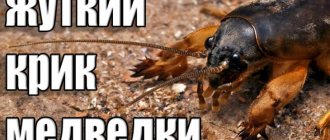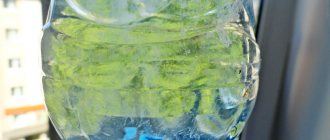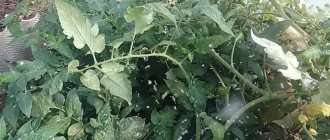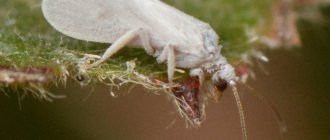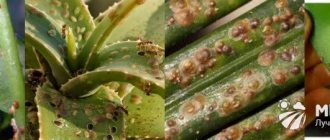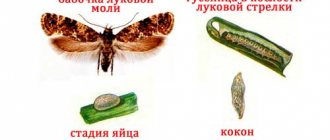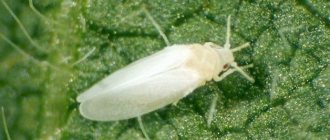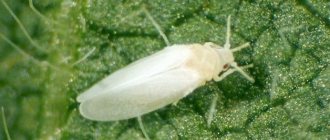Houseplants are often exposed to a variety of diseases and pests. One of these is the whitefly. This small, inconspicuous insect can cause enormous harm to the plant and even lead to its death. To avoid such sad consequences, you need to detect the pest in time and get rid of it. Fortunately, there are many ways to combat it. You can use both chemicals and folk remedies, which are no less effective.
Description and types of whitefly
It is not so easy to see whiteflies - they have tiny sizes, from 1.3. mm. up to 2.5. mm. depending on gender. They are necessarily white or predominantly white in color - only this feature makes them noticeable on the soil of the pot and the flower itself; they resemble moths in appearance.
REFERENCE! Adult whiteflies cause a lot of harm - for example, they spread phytoviruses. But the larvae of these insects are much more dangerous for plants - they eat a lot and quickly, and also securely attach themselves throughout the plant, destroying it.
It is easier to detect whiteflies in motion - having settled on a flower, they actively move around it and hide when a threat appears. If you see an insect but are not sure, look at photos of whiteflies on houseplants from other gardeners.
Tobacco or cotton
The main danger of these insects is the transfer of viruses to a variety of plants - not a single flower can be insured against this. The most common type.
Greenhouse or greenhouse
It is possible that your pests are of this particular species - it is the second most common. These insects breed all year round and can easily be carried into your apartment by the wind.
Asian or citrus
Not very common, it can mainly be found in the Caucasus or the Black Sea coast.
Most likely you will find representatives of the first two species on your plants. They reproduce quickly, and adults run away from danger - which is why it is necessary to destroy them as quickly as possible from the moment of discovery.
Description of the flying pest
The whitefly on flowers looks harmless, but causes great harm to plants. Outwardly, it looks like a small moth. You can recognize a whitefly by its white wings covered with a waxy powdery coating. The insect's body length is no more than 2-3 mm.
Whiteflies hide on the undersides of leaves and leave their eggs there. The danger comes mainly from the larvae - they feed on the juices of the plant, leading to its death. One female lays about 300 eggs per month. The lifespan of an insect is about a month.
Whiteflies are carriers of dangerous viral and infectious diseases. Due to its rapid reproduction and ability to fly, whiteflies are difficult to breed. If at least one insect is noticed on the plant, you need to carry out treatment as soon as possible and carefully inspect all the flowers in the house.
There are different types of whiteflies - greenhouse, citrus, strawberry. In apartments, greenhouses are most often installed. They do not disdain any plants; most often they attack pelargonium, balsam, fuchsia, gloxinia, and calla lilies.
Causes of pests
You don’t need to do anything specific for whiteflies to appear - these insects move with the wind, so they can settle completely by accident. Most often this happens in spring and summer, when the air is warm and the windows are open.
These parasites also infect the soil with their larvae - the eggs easily tolerate cold and begin to actively develop only in suitable conditions. To avoid this option, buy flower soil in a safe, sealed package, or take any soil, but process it at high temperatures.
How to detect
Whiteflies on indoor plants are noticeable due to their white color and chaotic movement. There can be a large number of adult insects on one flower at the same time, so you will most likely notice them quickly.
Most often, the pest hides under the leaves of the plant (if there are any - and the whitefly prefers deciduous species). Lift one leaf and shake it a little - the adults will scatter and you can see the small spherical capsules of the larvae. They are covered with a dense layer of waxy substance that protects them from almost any external influence.
How to identify larvae and adults?
This insect pierces the leaf shell with its chitinous proboscis and sucks out the juice. The punctures leave marks that show that there are whiteflies on the flowers.
Symptoms of damage look like this:
- yellow dots less than a millimeter in size appear on the leaves;
- with an increase in the number of pests, the number of points quickly increases, the leaves begin to fade;
- a sooty coating appears on the reverse side of the leaf;
- on the leaves under a magnifying glass you can see a clutch of yellow eggs laid in circles;
- There is a lot of honeydew on the leaves - whitefly excrement.
Signs of plant infection
You don't have to look out for insects to understand that something is wrong with the plant. There are several signs of infection, having noticed which you can definitely start thinking about how to treat your plants against whiteflies.
The main signs of the appearance of parasites:
- The plant itself fades - it begins to wither and turn yellow for no objective reason. This happens because adult insects introduce viruses and leave honeydew (more on that below), and the larvae feed abundantly on the juices of the flower.
- Honeydew or honeydew appears on the leaves and stem - a sticky silvery-white coating secreted by adult insects. If there are such traces, then the pests have already firmly established themselves on the plant.
- White, and then black, spots on the leaves and stems from sooty fungus. This sign suggests that saving the plant will no longer be easy. Sooty fungus appears shortly after honeydew - their development is interconnected.
If you notice any of these signs, look for insects or larvae. As soon as your fears are confirmed, try to figure out what phase of reproduction the pests are in - this is critically important for controlling whiteflies on plants.
IMPORTANT! Be sure to isolate the plant as soon as you notice signs of infection - this is a necessary measure so that other flowers are not harmed. Whiteflies quickly invade neighboring pots as soon as the population becomes too large.
Larvae and adults require different measures for eradication - keep this in mind. First of all, try to destroy all adult insects - they multiply very quickly, and then tackle the larvae.
How to deal with whitefly on indoor plants - reviews from gardeners
Lyudmila Ivanovna, 51 years old, Leningrad region:
My husband and I have a greenhouse, so we know firsthand about whiteflies. When she appeared in the house, they immediately realized that fighting with proven methods was not suitable - environmentally friendly means were needed here. Therefore, we decided not to resort to chemistry. To repel and kill insects, I use an infusion of ash, and I also sprinkle shag dust on the plants. Whitefly eggs are much more difficult to destroy, sometimes it comes to the point that I wipe the leaves with a solution of ammonia. In the fall, I’m thinking of taking out all the tubs to disinfect the soil and destroy larvae and adult pests. This is how we fight.
Maria Epifantseva, 43 years old, Pskov region:
There are a lot of different plants in the house - it’s beautiful, but there’s also a lot of hassle with them. Even despite our rather harsh climate, there are a lot of different pests in the region, among them the whitefly stands out for its gluttony. Since I don’t have extra time to care for plants, I fight pests using chemicals. In the spring, I take all the tubs and pots out onto the veranda, open the windows and treat them with Fitoverm at least twice with an interval of 7-8 days. In winter and early spring I water the soil with a weak solution of Aktara. As a rule, after using it for several days, all pests die.
Advantages of using Aktara insecticide : effectively controls the population of adult whiteflies, as well as their eggs and larvae, the drug can be used both for spraying and for watering plants, no unpleasant odor, affordable price;
Disadvantages: when processing plants, you must follow personal safety rules; it can harm bees and other beneficial insects.
Chemical treatment
To successfully combat whiteflies on indoor plants, reliable chemicals have long been invented - all you have to do is select and apply them correctly. Many gardeners are afraid that the chemicals will damage the plant, but all insecticides that are used to kill whiteflies are designed to have minimal impact on house flowers and other cultivated plants.
Most of the products that will help you kill these parasites are long-acting - this is necessary, since some whiteflies can survive after treatment, and this is enough to restore the colony. Having chosen a drug, use it exactly according to the instructions, observing the dosage - you need to destroy the entire population at one time.
Aktara is considered the best insecticide against whitefly.
This drug is used most often - flower growers choose it due to its long-lasting action and prevention of re-infection for almost a month. It has a complex effect - after watering, it impregnates the plant and its juices, which the parasites feed on, with a deadly poison for them. The entire colony dies within a week or 10 days - you don't need to do anything for this.
Traditional methods
Gardeners and summer residents in their small plots prefer to cope with the invasion of the parasite using traditional methods. The advantage of these methods is the absolute environmental friendliness of the fruit.
- An effective method is wiping with water. But the method is only suitable for indoor plants and a small number of seedlings. Take a sponge, soak it in water and wipe the leaves with it. The method is painstaking, but you know for sure that all the larvae have been removed.
- The composition of water and laundry soap is prepared in the proportion of 1 part soap to 6 parts water. Water the soil, but not too much, so as not to harm the roots and plant. Repeat in a week.
- Garlic tincture is prepared from 2 large cloves of garlic and 1 liter of hot water. Leave it to sit overnight and then you can spray it on.
- Yarrow tincture is prepared at the rate of 90 g of leaves per 1 liter of water. Let it brew for 2 days and spray the plants or seedlings. Repeat 3 times every other week.
- Tobacco solution. Experienced gardeners recommend using Prima cigarettes. The tobacco from them is poured into a jar and filled with water. Let it brew for 5 days, strain and spray. Repeat the treatment until the midges completely disappear.
- Dandelion tincture is prepared from 40 g of leaves, 40 g of roots, which are crushed and filled with water. Let it brew for 4 days, strain and process the plants.
- Ammonia is diluted 35 ml per 1 bucket of water. Treatment with ammonia is carried out every 3 days.
- Birch tar is part of tar tincture. Dilute 5 ml per 10 liters of water.
- The vinegar solution is prepared as follows: take 5 tablespoons per 10 liters of water. vinegar essence.
It is difficult to say which varieties of petunia, house rose or fuchsia are resistant to whitefly. But in order not to look for something that doesn’t exist, it is best to use preventive measures and fertilize plants with nitrogen compounds.
Other effective drugs
Spark
An insecticide identical in action to Aktara. Valid for 25 days.
Confidor and its analogues
Not only kills the main colony after watering, but also has a contact effect (only against adult insects).
Akarin
Contact and food poison for whiteflies. You should not relax immediately after treatment - you need to monitor the plant for some more time to make sure that the whitefly has died as a whole in the colony. Relapses often occur, to which it is worth responding just as quickly.
Advantages and disadvantages of agrochemicals
Advantages:
- They effectively destroy not only adult insects, but also their larvae and eggs;
- Some chemicals, in addition to medicinal ones, have stimulating properties;
- Large selection of drugs on the market.
Flaws:
- Not all chemicals can be used in residential areas; some of them have an unpleasant odor and can have a bad effect on people’s well-being;
- High-quality, low-toxic drugs have a high cost;
- Some chemicals can accumulate in the soil and in the plants themselves.
Non-chemical plant treatment
If you don’t have a chemical on hand, and you need to start understanding how to deal with whiteflies on indoor plants now, you can try methods that do not involve insecticides.
First, try to clean the plant mechanically - take it out into the open air and carefully shake off the adult insects, then take the pot away. Of course, you won’t be able to kill the entire colony this way, but you will improve the situation. Do not try to remove the larval cocoons - they are securely attached to the leaf, so you will only scratch the plant.
Another option is glue traps. Whiteflies are very light insects, so even a small layer of glue will be fatal to them. Traps can be purchased or made; bright yellow is recommended. You don't need to do anything - just place a few in and around the pot, the pests will stick to it on their own.
The best folk remedies for whiteflies
There are also effective folk remedies - with them, the fight against whiteflies is possible even on indoor plants with increased sensitivity to treatment. The first place to start is with processing and cleaning. Drive away as many insects as you can and start removing all the affected parts of the plant - leaves and shoots in the fungus. Remove honeydew too.
The most popular folk methods.
Garlic infusion
You need three cloves of garlic and a liter of boiling water - mix it and leave it in a dark place for a day. Spray the plant well with this liquid from a spray bottle, without watering it under any circumstances.
Soap solution
Prepare it carefully - you only need one tablespoon of grated soap and 6 liters of water. Reduce the proportions to the required level and spray; watering is also strictly forbidden.
Dichlorvos
Do not spray the plant directly, it is very harmful. Soak a piece of cotton wool in the chemical, place it in the pot and place the flower in a bag or bag that can be tied. After tying it, leave it for five hours.
If this does not help, it is recommended to return to insecticides - it is better to risk the health of the plant a little (although the likelihood of this is exaggerated) than to risk losing it completely.
Features of whitefly
Despite the fact that there are a huge number of species of whiteflies, the length of this insect varies from 0.13 to 0.3 cm. Externally, it is similar to the mole-shaped lepidoptera. There are small spots of dark color on the surface of the reddish-yellow body; the whitefly has four wings, and they fold into a house; on their surface there is a powdery white dusty coating. Young larvae are very mobile, and they use the sap of various plants as food. Over time, they attach to the underside of the sheet plates. Some whitefly species are classified as dangerous quarantine pests.
You can tell that a plant has been occupied by a whitefly by the following signs:
- when you touch a plant, white midges fly up from it, which look like a very small moth;
- translucent scales have formed on the underside of the foliage, which represent pest larvae;
- yellow chlorotic spots form on the shoots and foliage, and then a sticky coating appears, which is honeydew or honeydew (this is a waste product of the whitefly);
- plant growth and development slows down.
This pest prefers warmth and high air humidity, which is why it reproduces well in greenhouses and conservatories. Already at 10 degrees the whitefly dies, but its eggs can easily withstand even winter frosts. This most dangerous pest is also one of the main carriers of fungal and also viral diseases (for example, curl, gray mold, mosaic, powdery mildew, etc.), which today are considered incurable.
Processing rules
Depending on the substance, one of the treatment methods is selected - watering or spraying. Most insecticides work in the first way - in order to saturate the plant and kill numerous larvae, folk remedies, on the contrary, usually require spraying.
Often these measures intersect with each other in a variety of processing methods. Experienced gardeners advise not to neglect spraying in any case.
Prevention measures
You won’t be able to completely protect your flowers from the possible appearance of whiteflies - but you can do everything possible. The best thing you can do to keep your houseplants safe is to install mosquito nets.
IMPORTANT! It is highly likely that you will get whiteflies if you grow tomatoes at home - these pests love them very much. Try to keep such seedlings away from flowers.
It is not worth treating plants with chemicals prophylactically - this can be harmful. Try to inspect the flowers more often. As soon as you notice several individuals, be sure to kill them - this way you can prevent the emergence of a colony.


